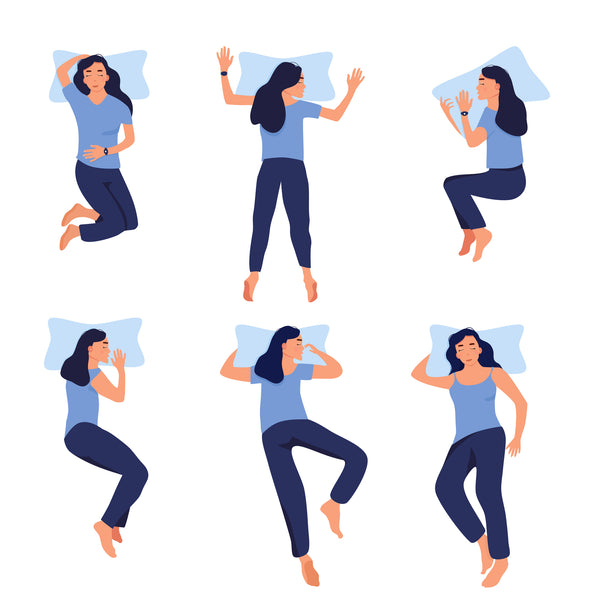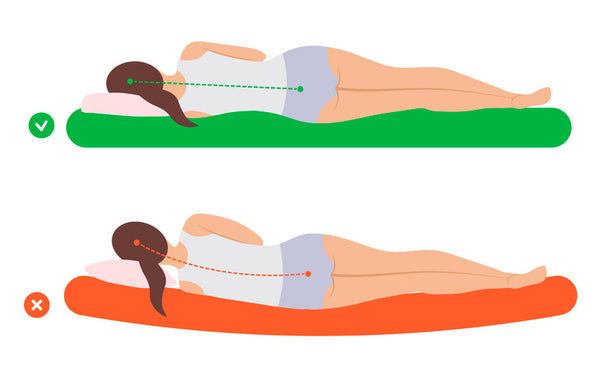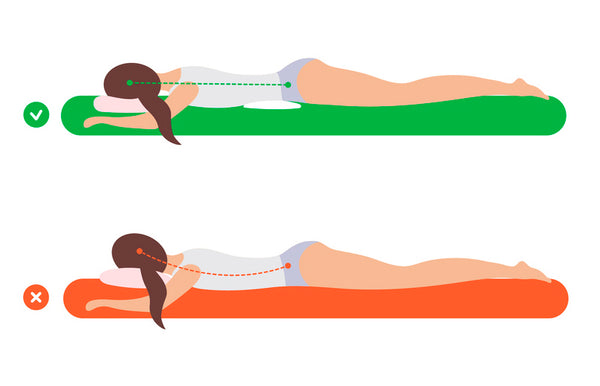What is the Best Position to Sleep in?
While we sleep, our body is hard at work restoring and repairing itself to function optimally for the day ahead. Your sleeping position can greatly affect the quality of your sleep, depending on how effectively it supports the natural curve of your spine. As we spend a third of our lives asleep or resting, choosing a sleeping position that best assists your body with its physical recovery process is important. A good sleeping position can relieve stress on your spine, while an unhealthy position can lead to low-quality sleep and increase the amount of aches and pains you wake up with.
The best sleeping position differs per person. Ideally, you want to position yourself in a way that promotes healthy spinal alignment from your hips all the way to your head. What that looks like for you depends on what you find most comfortable for your body.

In general, sleeping on your side or back is considered most beneficial for your nightly recovery than sleeping on your stomach, as these positions make it easier to keep your spine supported and balanced throughout the night. However that doesn’t mean you shouldn’t sleep on your stomach if it's what feels most comfortable, we just recommend choosing the right mattress and pillow to best support your spinal alignment as you rest.
Sleeping on your side
Sleeping on your side is the most popular way to sleep, with over 60% of the population choosing this position. As the flexibility of our spine decreases as we age, side sleeping does tend to be the most comfortable sleeping position for adults. Sleeping on your side can offer benefits that other positions cannot, such as the reduction of back pain, neck pain, heartburn and snoring. Side sleeping is also heavily recommended for pregnant women and older people as it offers the most spinal support throughout the night. However for those suffering from shoulder pain, side sleeping is not recommended as this position can put further stress on your shoulders.

What is the best bedding for a side sleeper?
For a side sleeper, the best mattress can depend on personal preference, however it is generally recommended to opt for a mattress with medium firmness to support spinal alignment. Medium mattresses tend to contour to the shape of your body, therefore relieving pressure while still providing support. Side sleepers are also most likely to change positions throughout the night so a mattress with some softness can make this more comfortable. Side sleepers should also consider a high pillow, as this keeps your head aligned with your spine. Opting for a firm pillow will further help prevent your head from sinking down too low which can cause neck and back aches.
Sleeping on your back
Sleeping on your back is the second most common sleeping position, promoting many benefits for achieving a healthy night's sleep. When lying flat on your back, your body weight is most evenly distributed and your spine is in its best alignment, preventing any neck or back aches. It can also be great for those suffering from a stuffy nose or allergies, as it can relieve congestion throughout the night if your head is placed in an upright position. For those concerned about acne or wrinkles, back sleeping could be your best bet as doing so leaves your skin free to breathe throughout the night instead of being squished up against your pillow.

What is the best bedding for a back sleeper?
In terms of mattresses for back sleepers, there are a few things to consider. In order to provide the necessary spinal support, a mattress must have the right firmness to provide support to both the hips and shoulders without putting too much pressure on them. As such, an even sleep surface that is able to conform to your body without sagging is preferable.
For back sleepers, firmness required can differ depending on body types. Average-weight back sleepers often find the most comfort with a medium to medium firm mattress, whereas lighter sleepers may opt for a softer option and heavier weight sleepers tend to favour a firmer model. When choosing a pillow, medium pillows in both height and firmness tend to be the best option, as these best promote spinal alignment when laying on your back.
Sleeping on your stomach
While we all tend to start off sleeping on our stomachs as children, as we age sleeping on the stomach becomes less popular amongst adults. This position provides the least amount of back support as compared to sleeping on your back or side, therefore increasing pressure on your spine.
Stomach sleepers also sleep with their head turned to one side, twisting their neck and head out of alignment with the rest of their spine which can cause back and neck pain. Sleeping on your stomach can also cause you to use more energy while you sleep as your ribs have to work against gravity in order to breathe in this position, in turn making your sleep less restful.

What is the best bedding for a stomach sleeper?
If stomach sleeping is for you then don’t feel inclined to change it, with the right pillows and mattress you can still get a restful night's sleep. We recommend using a low profile pillow, or even no pillow at all, to avoid any extra strain on your neck. Placing a thin pillow under your hips will also help to even out your spine as you sleep to relieve any pressure. A firm mattress is also recommended, as this prevents you from sinking into the mattress and stretching your spine out of alignment.
In conclusion, the best sleeping position is the one that feels most comfortable for you. With the correct bedding, any position can promote a restful and restorative night’s sleep, allowing you to wake up in the morning feeling refreshed and free of any aches and pains. For more help with choosing the correct bedding for you, use our interactive buying guide or contact our friendly team for assistance.










